Understanding Medical Negligence in Australian Law
VerifiedAdded on 2022/12/16
|11
|3129
|473
AI Summary
This article provides an in-depth understanding of medical negligence in Australian law. It discusses the duty of care, standard of care, and liability of doctors. It explores landmark cases and the impact of negligence on doctors and patients. The article also highlights the importance of maintaining the welfare of patients and the role of legislation in promoting proper medical care.
Contribute Materials
Your contribution can guide someone’s learning journey. Share your
documents today.

Essay
Secure Best Marks with AI Grader
Need help grading? Try our AI Grader for instant feedback on your assignments.
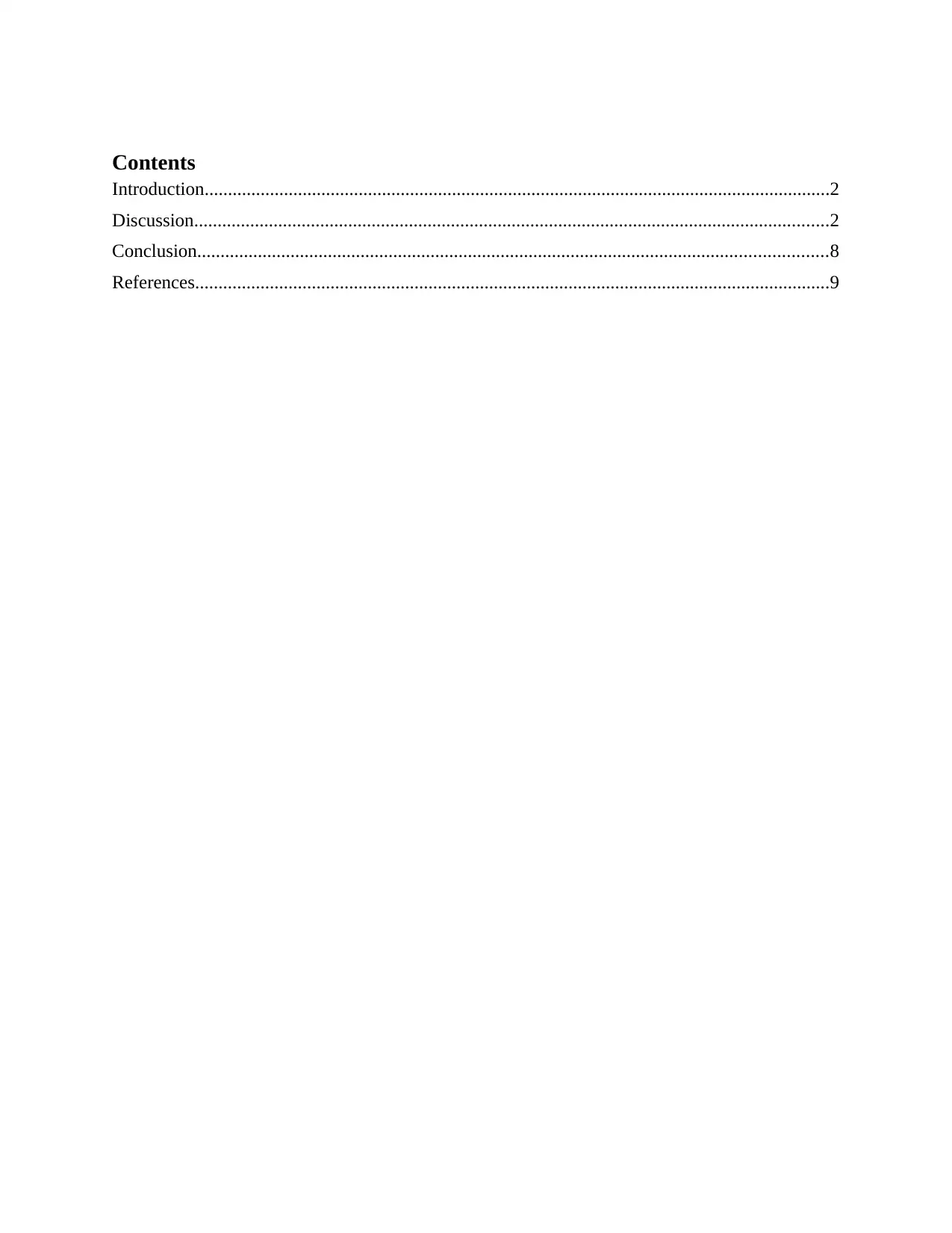
Contents
Introduction......................................................................................................................................2
Discussion........................................................................................................................................2
Conclusion.......................................................................................................................................8
References........................................................................................................................................9
Introduction......................................................................................................................................2
Discussion........................................................................................................................................2
Conclusion.......................................................................................................................................8
References........................................................................................................................................9
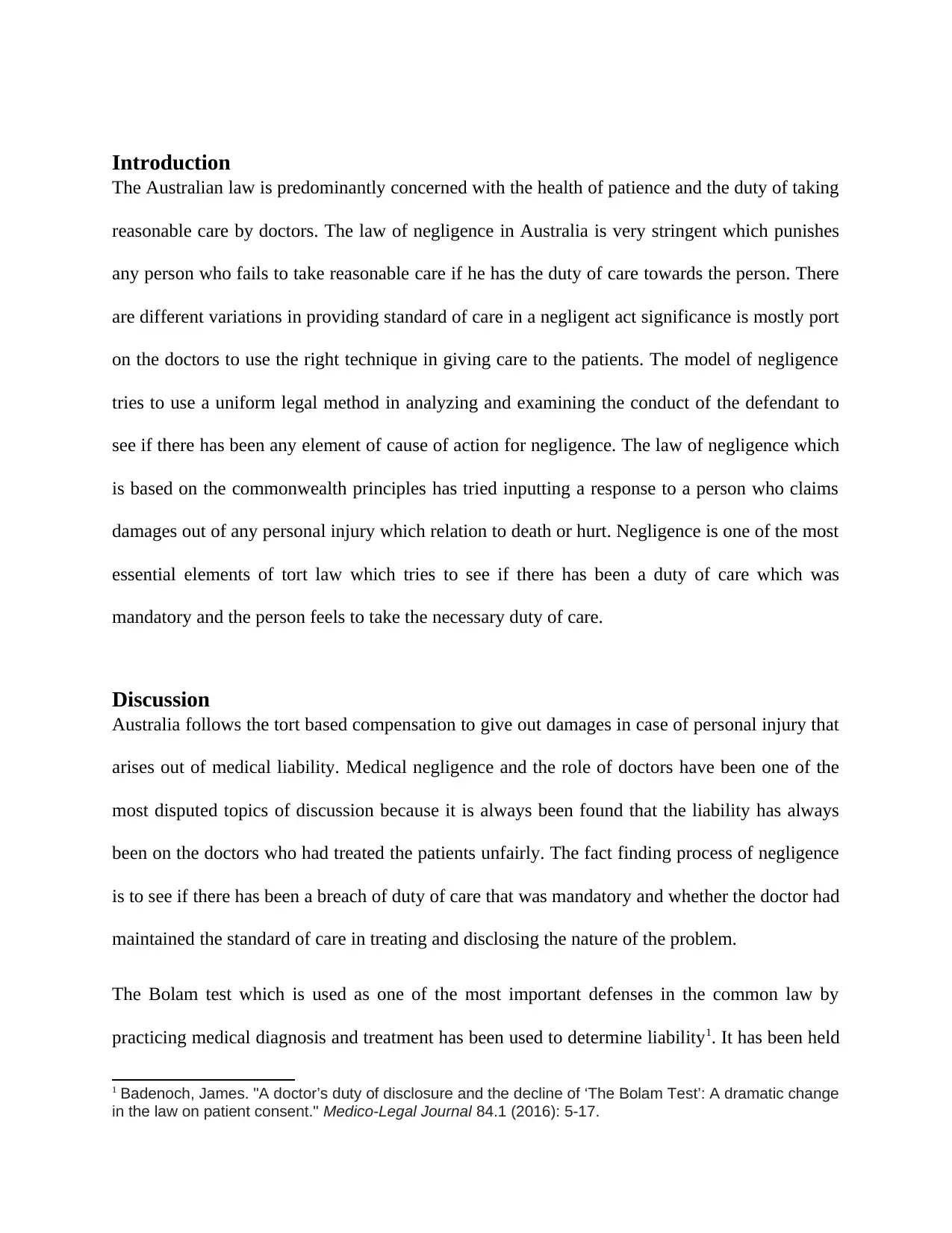
Introduction
The Australian law is predominantly concerned with the health of patience and the duty of taking
reasonable care by doctors. The law of negligence in Australia is very stringent which punishes
any person who fails to take reasonable care if he has the duty of care towards the person. There
are different variations in providing standard of care in a negligent act significance is mostly port
on the doctors to use the right technique in giving care to the patients. The model of negligence
tries to use a uniform legal method in analyzing and examining the conduct of the defendant to
see if there has been any element of cause of action for negligence. The law of negligence which
is based on the commonwealth principles has tried inputting a response to a person who claims
damages out of any personal injury which relation to death or hurt. Negligence is one of the most
essential elements of tort law which tries to see if there has been a duty of care which was
mandatory and the person feels to take the necessary duty of care.
Discussion
Australia follows the tort based compensation to give out damages in case of personal injury that
arises out of medical liability. Medical negligence and the role of doctors have been one of the
most disputed topics of discussion because it is always been found that the liability has always
been on the doctors who had treated the patients unfairly. The fact finding process of negligence
is to see if there has been a breach of duty of care that was mandatory and whether the doctor had
maintained the standard of care in treating and disclosing the nature of the problem.
The Bolam test which is used as one of the most important defenses in the common law by
practicing medical diagnosis and treatment has been used to determine liability1. It has been held
1 Badenoch, James. "A doctor’s duty of disclosure and the decline of ‘The Bolam Test’: A dramatic change
in the law on patient consent." Medico-Legal Journal 84.1 (2016): 5-17.
The Australian law is predominantly concerned with the health of patience and the duty of taking
reasonable care by doctors. The law of negligence in Australia is very stringent which punishes
any person who fails to take reasonable care if he has the duty of care towards the person. There
are different variations in providing standard of care in a negligent act significance is mostly port
on the doctors to use the right technique in giving care to the patients. The model of negligence
tries to use a uniform legal method in analyzing and examining the conduct of the defendant to
see if there has been any element of cause of action for negligence. The law of negligence which
is based on the commonwealth principles has tried inputting a response to a person who claims
damages out of any personal injury which relation to death or hurt. Negligence is one of the most
essential elements of tort law which tries to see if there has been a duty of care which was
mandatory and the person feels to take the necessary duty of care.
Discussion
Australia follows the tort based compensation to give out damages in case of personal injury that
arises out of medical liability. Medical negligence and the role of doctors have been one of the
most disputed topics of discussion because it is always been found that the liability has always
been on the doctors who had treated the patients unfairly. The fact finding process of negligence
is to see if there has been a breach of duty of care that was mandatory and whether the doctor had
maintained the standard of care in treating and disclosing the nature of the problem.
The Bolam test which is used as one of the most important defenses in the common law by
practicing medical diagnosis and treatment has been used to determine liability1. It has been held
1 Badenoch, James. "A doctor’s duty of disclosure and the decline of ‘The Bolam Test’: A dramatic change
in the law on patient consent." Medico-Legal Journal 84.1 (2016): 5-17.
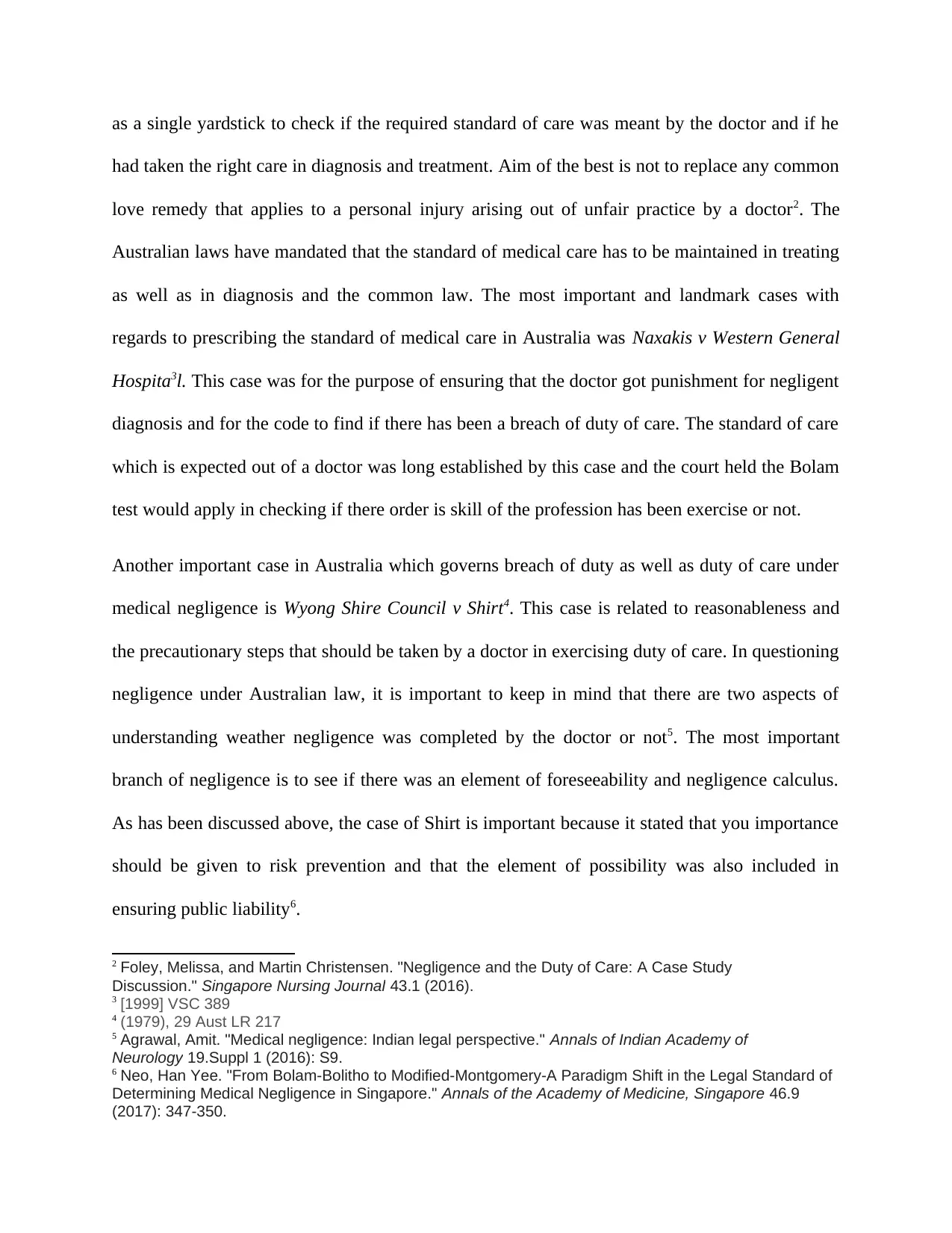
as a single yardstick to check if the required standard of care was meant by the doctor and if he
had taken the right care in diagnosis and treatment. Aim of the best is not to replace any common
love remedy that applies to a personal injury arising out of unfair practice by a doctor2. The
Australian laws have mandated that the standard of medical care has to be maintained in treating
as well as in diagnosis and the common law. The most important and landmark cases with
regards to prescribing the standard of medical care in Australia was Naxakis v Western General
Hospita3l. This case was for the purpose of ensuring that the doctor got punishment for negligent
diagnosis and for the code to find if there has been a breach of duty of care. The standard of care
which is expected out of a doctor was long established by this case and the court held the Bolam
test would apply in checking if there order is skill of the profession has been exercise or not.
Another important case in Australia which governs breach of duty as well as duty of care under
medical negligence is Wyong Shire Council v Shirt4. This case is related to reasonableness and
the precautionary steps that should be taken by a doctor in exercising duty of care. In questioning
negligence under Australian law, it is important to keep in mind that there are two aspects of
understanding weather negligence was completed by the doctor or not5. The most important
branch of negligence is to see if there was an element of foreseeability and negligence calculus.
As has been discussed above, the case of Shirt is important because it stated that you importance
should be given to risk prevention and that the element of possibility was also included in
ensuring public liability6.
2 Foley, Melissa, and Martin Christensen. "Negligence and the Duty of Care: A Case Study
Discussion." Singapore Nursing Journal 43.1 (2016).
3 [1999] VSC 389
4 (1979), 29 Aust LR 217
5 Agrawal, Amit. "Medical negligence: Indian legal perspective." Annals of Indian Academy of
Neurology 19.Suppl 1 (2016): S9.
6 Neo, Han Yee. "From Bolam-Bolitho to Modified-Montgomery-A Paradigm Shift in the Legal Standard of
Determining Medical Negligence in Singapore." Annals of the Academy of Medicine, Singapore 46.9
(2017): 347-350.
had taken the right care in diagnosis and treatment. Aim of the best is not to replace any common
love remedy that applies to a personal injury arising out of unfair practice by a doctor2. The
Australian laws have mandated that the standard of medical care has to be maintained in treating
as well as in diagnosis and the common law. The most important and landmark cases with
regards to prescribing the standard of medical care in Australia was Naxakis v Western General
Hospita3l. This case was for the purpose of ensuring that the doctor got punishment for negligent
diagnosis and for the code to find if there has been a breach of duty of care. The standard of care
which is expected out of a doctor was long established by this case and the court held the Bolam
test would apply in checking if there order is skill of the profession has been exercise or not.
Another important case in Australia which governs breach of duty as well as duty of care under
medical negligence is Wyong Shire Council v Shirt4. This case is related to reasonableness and
the precautionary steps that should be taken by a doctor in exercising duty of care. In questioning
negligence under Australian law, it is important to keep in mind that there are two aspects of
understanding weather negligence was completed by the doctor or not5. The most important
branch of negligence is to see if there was an element of foreseeability and negligence calculus.
As has been discussed above, the case of Shirt is important because it stated that you importance
should be given to risk prevention and that the element of possibility was also included in
ensuring public liability6.
2 Foley, Melissa, and Martin Christensen. "Negligence and the Duty of Care: A Case Study
Discussion." Singapore Nursing Journal 43.1 (2016).
3 [1999] VSC 389
4 (1979), 29 Aust LR 217
5 Agrawal, Amit. "Medical negligence: Indian legal perspective." Annals of Indian Academy of
Neurology 19.Suppl 1 (2016): S9.
6 Neo, Han Yee. "From Bolam-Bolitho to Modified-Montgomery-A Paradigm Shift in the Legal Standard of
Determining Medical Negligence in Singapore." Annals of the Academy of Medicine, Singapore 46.9
(2017): 347-350.
Secure Best Marks with AI Grader
Need help grading? Try our AI Grader for instant feedback on your assignments.
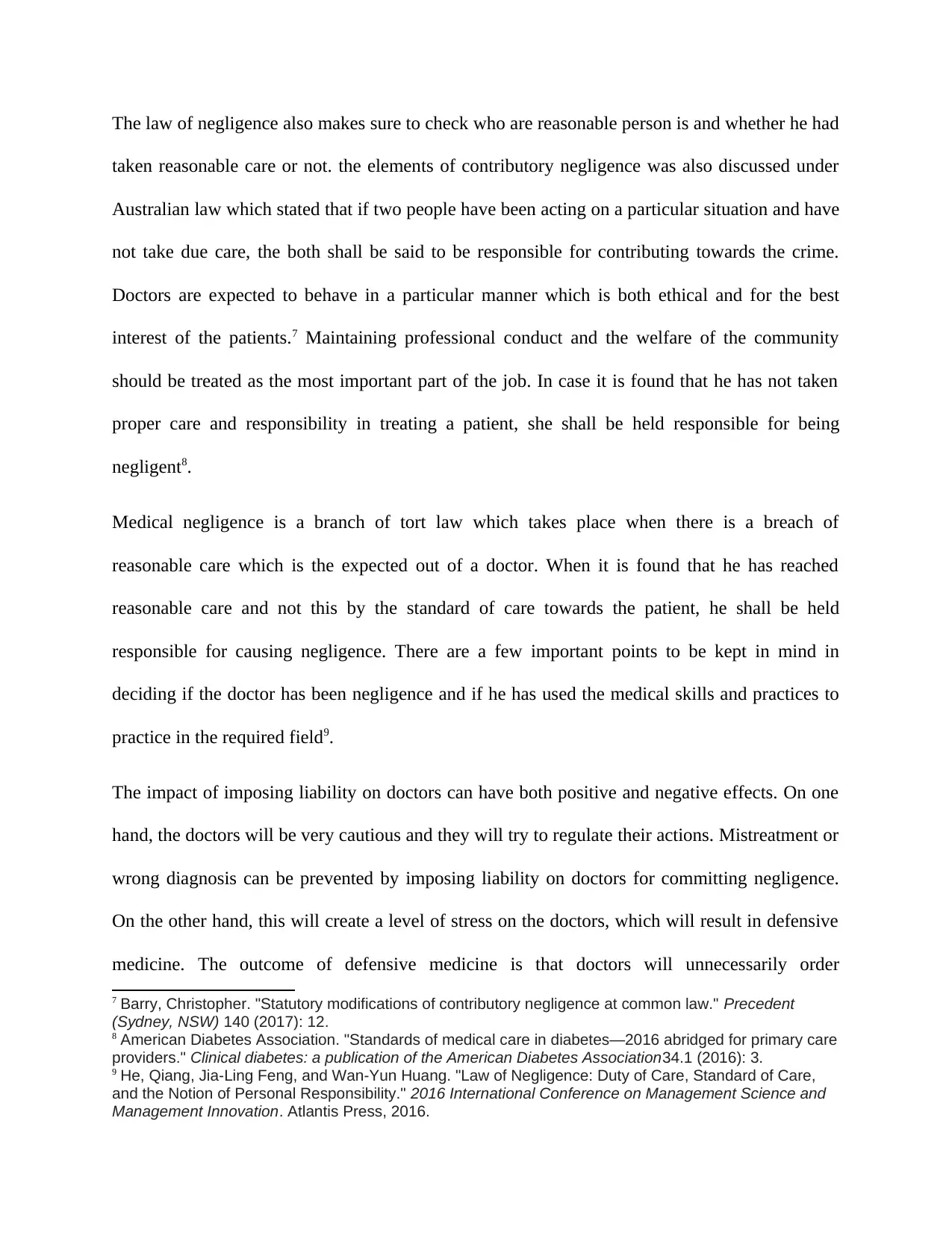
The law of negligence also makes sure to check who are reasonable person is and whether he had
taken reasonable care or not. the elements of contributory negligence was also discussed under
Australian law which stated that if two people have been acting on a particular situation and have
not take due care, the both shall be said to be responsible for contributing towards the crime.
Doctors are expected to behave in a particular manner which is both ethical and for the best
interest of the patients.7 Maintaining professional conduct and the welfare of the community
should be treated as the most important part of the job. In case it is found that he has not taken
proper care and responsibility in treating a patient, she shall be held responsible for being
negligent8.
Medical negligence is a branch of tort law which takes place when there is a breach of
reasonable care which is the expected out of a doctor. When it is found that he has reached
reasonable care and not this by the standard of care towards the patient, he shall be held
responsible for causing negligence. There are a few important points to be kept in mind in
deciding if the doctor has been negligence and if he has used the medical skills and practices to
practice in the required field9.
The impact of imposing liability on doctors can have both positive and negative effects. On one
hand, the doctors will be very cautious and they will try to regulate their actions. Mistreatment or
wrong diagnosis can be prevented by imposing liability on doctors for committing negligence.
On the other hand, this will create a level of stress on the doctors, which will result in defensive
medicine. The outcome of defensive medicine is that doctors will unnecessarily order
7 Barry, Christopher. "Statutory modifications of contributory negligence at common law." Precedent
(Sydney, NSW) 140 (2017): 12.
8 American Diabetes Association. "Standards of medical care in diabetes—2016 abridged for primary care
providers." Clinical diabetes: a publication of the American Diabetes Association34.1 (2016): 3.
9 He, Qiang, Jia-Ling Feng, and Wan-Yun Huang. "Law of Negligence: Duty of Care, Standard of Care,
and the Notion of Personal Responsibility." 2016 International Conference on Management Science and
Management Innovation. Atlantis Press, 2016.
taken reasonable care or not. the elements of contributory negligence was also discussed under
Australian law which stated that if two people have been acting on a particular situation and have
not take due care, the both shall be said to be responsible for contributing towards the crime.
Doctors are expected to behave in a particular manner which is both ethical and for the best
interest of the patients.7 Maintaining professional conduct and the welfare of the community
should be treated as the most important part of the job. In case it is found that he has not taken
proper care and responsibility in treating a patient, she shall be held responsible for being
negligent8.
Medical negligence is a branch of tort law which takes place when there is a breach of
reasonable care which is the expected out of a doctor. When it is found that he has reached
reasonable care and not this by the standard of care towards the patient, he shall be held
responsible for causing negligence. There are a few important points to be kept in mind in
deciding if the doctor has been negligence and if he has used the medical skills and practices to
practice in the required field9.
The impact of imposing liability on doctors can have both positive and negative effects. On one
hand, the doctors will be very cautious and they will try to regulate their actions. Mistreatment or
wrong diagnosis can be prevented by imposing liability on doctors for committing negligence.
On the other hand, this will create a level of stress on the doctors, which will result in defensive
medicine. The outcome of defensive medicine is that doctors will unnecessarily order
7 Barry, Christopher. "Statutory modifications of contributory negligence at common law." Precedent
(Sydney, NSW) 140 (2017): 12.
8 American Diabetes Association. "Standards of medical care in diabetes—2016 abridged for primary care
providers." Clinical diabetes: a publication of the American Diabetes Association34.1 (2016): 3.
9 He, Qiang, Jia-Ling Feng, and Wan-Yun Huang. "Law of Negligence: Duty of Care, Standard of Care,
and the Notion of Personal Responsibility." 2016 International Conference on Management Science and
Management Innovation. Atlantis Press, 2016.
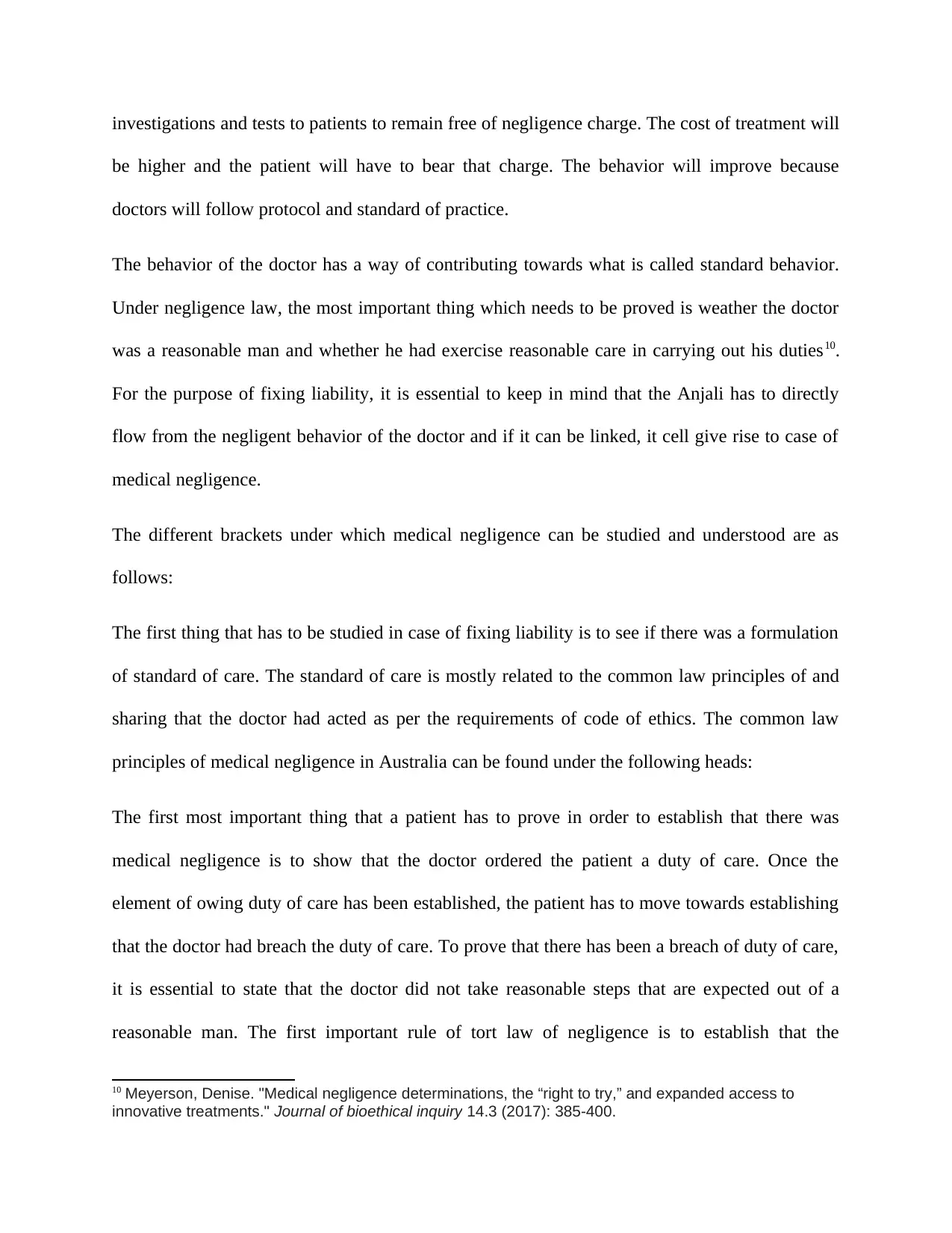
investigations and tests to patients to remain free of negligence charge. The cost of treatment will
be higher and the patient will have to bear that charge. The behavior will improve because
doctors will follow protocol and standard of practice.
The behavior of the doctor has a way of contributing towards what is called standard behavior.
Under negligence law, the most important thing which needs to be proved is weather the doctor
was a reasonable man and whether he had exercise reasonable care in carrying out his duties10.
For the purpose of fixing liability, it is essential to keep in mind that the Anjali has to directly
flow from the negligent behavior of the doctor and if it can be linked, it cell give rise to case of
medical negligence.
The different brackets under which medical negligence can be studied and understood are as
follows:
The first thing that has to be studied in case of fixing liability is to see if there was a formulation
of standard of care. The standard of care is mostly related to the common law principles of and
sharing that the doctor had acted as per the requirements of code of ethics. The common law
principles of medical negligence in Australia can be found under the following heads:
The first most important thing that a patient has to prove in order to establish that there was
medical negligence is to show that the doctor ordered the patient a duty of care. Once the
element of owing duty of care has been established, the patient has to move towards establishing
that the doctor had breach the duty of care. To prove that there has been a breach of duty of care,
it is essential to state that the doctor did not take reasonable steps that are expected out of a
reasonable man. The first important rule of tort law of negligence is to establish that the
10 Meyerson, Denise. "Medical negligence determinations, the “right to try,” and expanded access to
innovative treatments." Journal of bioethical inquiry 14.3 (2017): 385-400.
be higher and the patient will have to bear that charge. The behavior will improve because
doctors will follow protocol and standard of practice.
The behavior of the doctor has a way of contributing towards what is called standard behavior.
Under negligence law, the most important thing which needs to be proved is weather the doctor
was a reasonable man and whether he had exercise reasonable care in carrying out his duties10.
For the purpose of fixing liability, it is essential to keep in mind that the Anjali has to directly
flow from the negligent behavior of the doctor and if it can be linked, it cell give rise to case of
medical negligence.
The different brackets under which medical negligence can be studied and understood are as
follows:
The first thing that has to be studied in case of fixing liability is to see if there was a formulation
of standard of care. The standard of care is mostly related to the common law principles of and
sharing that the doctor had acted as per the requirements of code of ethics. The common law
principles of medical negligence in Australia can be found under the following heads:
The first most important thing that a patient has to prove in order to establish that there was
medical negligence is to show that the doctor ordered the patient a duty of care. Once the
element of owing duty of care has been established, the patient has to move towards establishing
that the doctor had breach the duty of care. To prove that there has been a breach of duty of care,
it is essential to state that the doctor did not take reasonable steps that are expected out of a
reasonable man. The first important rule of tort law of negligence is to establish that the
10 Meyerson, Denise. "Medical negligence determinations, the “right to try,” and expanded access to
innovative treatments." Journal of bioethical inquiry 14.3 (2017): 385-400.
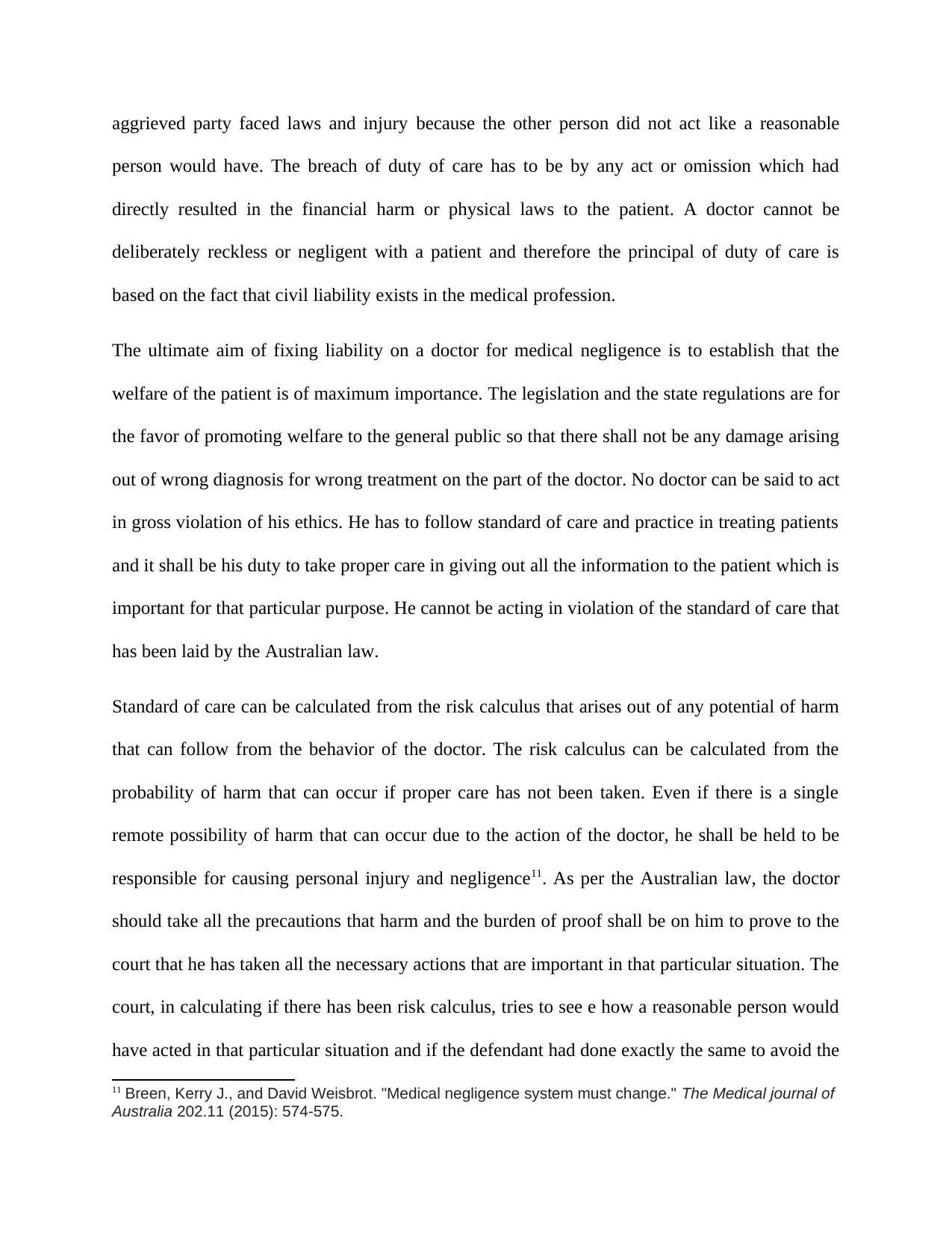
aggrieved party faced laws and injury because the other person did not act like a reasonable
person would have. The breach of duty of care has to be by any act or omission which had
directly resulted in the financial harm or physical laws to the patient. A doctor cannot be
deliberately reckless or negligent with a patient and therefore the principal of duty of care is
based on the fact that civil liability exists in the medical profession.
The ultimate aim of fixing liability on a doctor for medical negligence is to establish that the
welfare of the patient is of maximum importance. The legislation and the state regulations are for
the favor of promoting welfare to the general public so that there shall not be any damage arising
out of wrong diagnosis for wrong treatment on the part of the doctor. No doctor can be said to act
in gross violation of his ethics. He has to follow standard of care and practice in treating patients
and it shall be his duty to take proper care in giving out all the information to the patient which is
important for that particular purpose. He cannot be acting in violation of the standard of care that
has been laid by the Australian law.
Standard of care can be calculated from the risk calculus that arises out of any potential of harm
that can follow from the behavior of the doctor. The risk calculus can be calculated from the
probability of harm that can occur if proper care has not been taken. Even if there is a single
remote possibility of harm that can occur due to the action of the doctor, he shall be held to be
responsible for causing personal injury and negligence11. As per the Australian law, the doctor
should take all the precautions that harm and the burden of proof shall be on him to prove to the
court that he has taken all the necessary actions that are important in that particular situation. The
court, in calculating if there has been risk calculus, tries to see e how a reasonable person would
have acted in that particular situation and if the defendant had done exactly the same to avoid the
11 Breen, Kerry J., and David Weisbrot. "Medical negligence system must change." The Medical journal of
Australia 202.11 (2015): 574-575.
person would have. The breach of duty of care has to be by any act or omission which had
directly resulted in the financial harm or physical laws to the patient. A doctor cannot be
deliberately reckless or negligent with a patient and therefore the principal of duty of care is
based on the fact that civil liability exists in the medical profession.
The ultimate aim of fixing liability on a doctor for medical negligence is to establish that the
welfare of the patient is of maximum importance. The legislation and the state regulations are for
the favor of promoting welfare to the general public so that there shall not be any damage arising
out of wrong diagnosis for wrong treatment on the part of the doctor. No doctor can be said to act
in gross violation of his ethics. He has to follow standard of care and practice in treating patients
and it shall be his duty to take proper care in giving out all the information to the patient which is
important for that particular purpose. He cannot be acting in violation of the standard of care that
has been laid by the Australian law.
Standard of care can be calculated from the risk calculus that arises out of any potential of harm
that can follow from the behavior of the doctor. The risk calculus can be calculated from the
probability of harm that can occur if proper care has not been taken. Even if there is a single
remote possibility of harm that can occur due to the action of the doctor, he shall be held to be
responsible for causing personal injury and negligence11. As per the Australian law, the doctor
should take all the precautions that harm and the burden of proof shall be on him to prove to the
court that he has taken all the necessary actions that are important in that particular situation. The
court, in calculating if there has been risk calculus, tries to see e how a reasonable person would
have acted in that particular situation and if the defendant had done exactly the same to avoid the
11 Breen, Kerry J., and David Weisbrot. "Medical negligence system must change." The Medical journal of
Australia 202.11 (2015): 574-575.
Paraphrase This Document
Need a fresh take? Get an instant paraphrase of this document with our AI Paraphraser
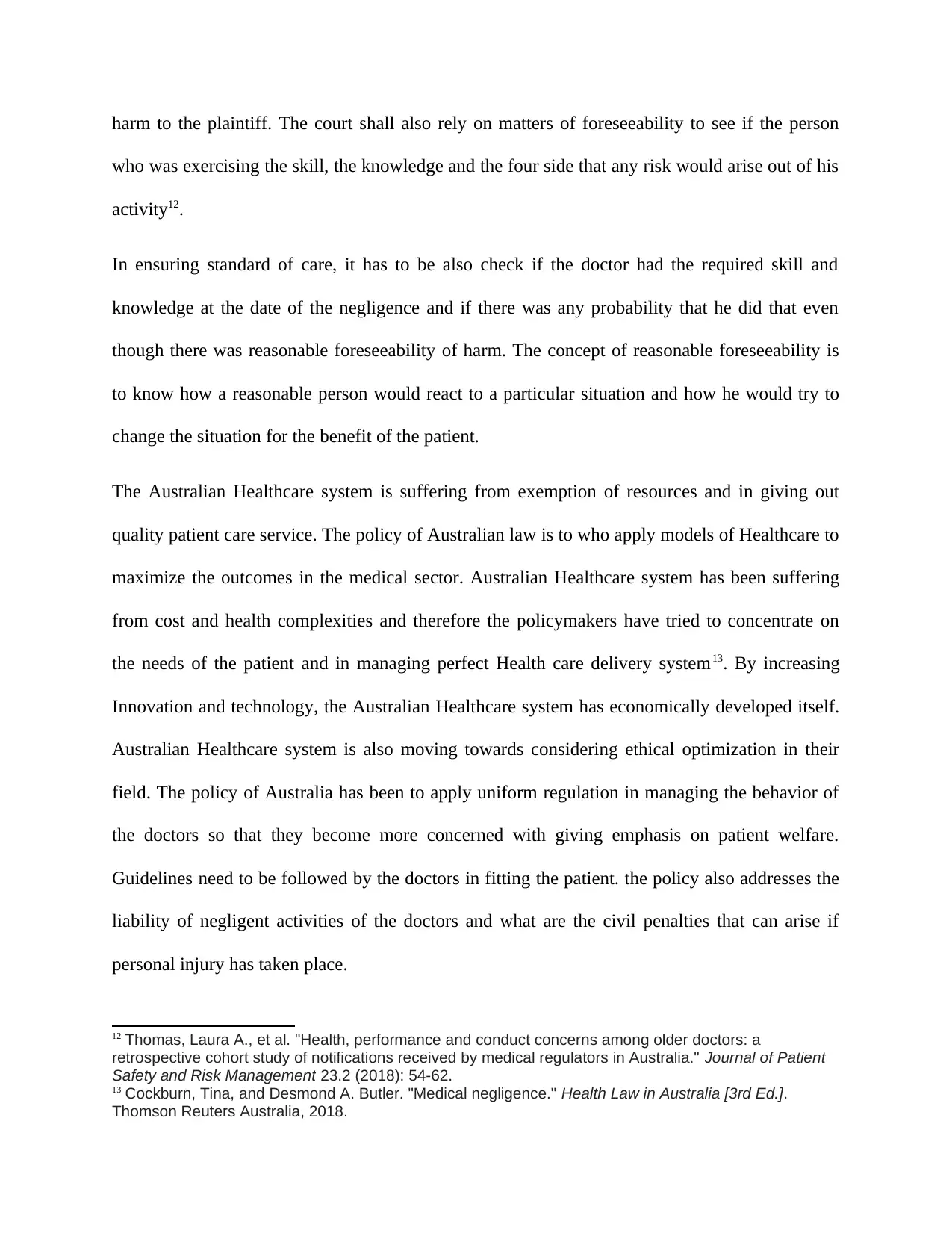
harm to the plaintiff. The court shall also rely on matters of foreseeability to see if the person
who was exercising the skill, the knowledge and the four side that any risk would arise out of his
activity12.
In ensuring standard of care, it has to be also check if the doctor had the required skill and
knowledge at the date of the negligence and if there was any probability that he did that even
though there was reasonable foreseeability of harm. The concept of reasonable foreseeability is
to know how a reasonable person would react to a particular situation and how he would try to
change the situation for the benefit of the patient.
The Australian Healthcare system is suffering from exemption of resources and in giving out
quality patient care service. The policy of Australian law is to who apply models of Healthcare to
maximize the outcomes in the medical sector. Australian Healthcare system has been suffering
from cost and health complexities and therefore the policymakers have tried to concentrate on
the needs of the patient and in managing perfect Health care delivery system13. By increasing
Innovation and technology, the Australian Healthcare system has economically developed itself.
Australian Healthcare system is also moving towards considering ethical optimization in their
field. The policy of Australia has been to apply uniform regulation in managing the behavior of
the doctors so that they become more concerned with giving emphasis on patient welfare.
Guidelines need to be followed by the doctors in fitting the patient. the policy also addresses the
liability of negligent activities of the doctors and what are the civil penalties that can arise if
personal injury has taken place.
12 Thomas, Laura A., et al. "Health, performance and conduct concerns among older doctors: a
retrospective cohort study of notifications received by medical regulators in Australia." Journal of Patient
Safety and Risk Management 23.2 (2018): 54-62.
13 Cockburn, Tina, and Desmond A. Butler. "Medical negligence." Health Law in Australia [3rd Ed.].
Thomson Reuters Australia, 2018.
who was exercising the skill, the knowledge and the four side that any risk would arise out of his
activity12.
In ensuring standard of care, it has to be also check if the doctor had the required skill and
knowledge at the date of the negligence and if there was any probability that he did that even
though there was reasonable foreseeability of harm. The concept of reasonable foreseeability is
to know how a reasonable person would react to a particular situation and how he would try to
change the situation for the benefit of the patient.
The Australian Healthcare system is suffering from exemption of resources and in giving out
quality patient care service. The policy of Australian law is to who apply models of Healthcare to
maximize the outcomes in the medical sector. Australian Healthcare system has been suffering
from cost and health complexities and therefore the policymakers have tried to concentrate on
the needs of the patient and in managing perfect Health care delivery system13. By increasing
Innovation and technology, the Australian Healthcare system has economically developed itself.
Australian Healthcare system is also moving towards considering ethical optimization in their
field. The policy of Australia has been to apply uniform regulation in managing the behavior of
the doctors so that they become more concerned with giving emphasis on patient welfare.
Guidelines need to be followed by the doctors in fitting the patient. the policy also addresses the
liability of negligent activities of the doctors and what are the civil penalties that can arise if
personal injury has taken place.
12 Thomas, Laura A., et al. "Health, performance and conduct concerns among older doctors: a
retrospective cohort study of notifications received by medical regulators in Australia." Journal of Patient
Safety and Risk Management 23.2 (2018): 54-62.
13 Cockburn, Tina, and Desmond A. Butler. "Medical negligence." Health Law in Australia [3rd Ed.].
Thomson Reuters Australia, 2018.
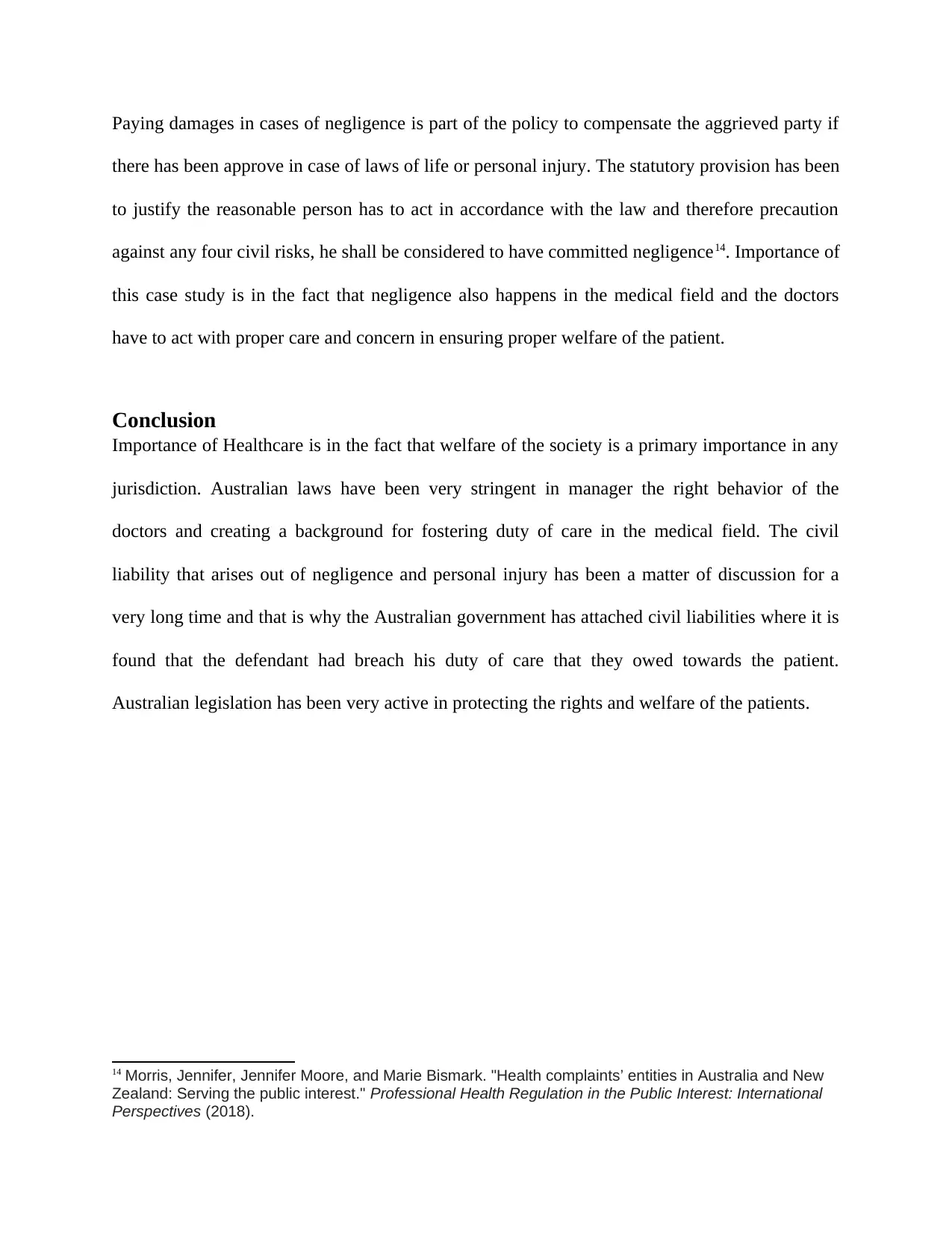
Paying damages in cases of negligence is part of the policy to compensate the aggrieved party if
there has been approve in case of laws of life or personal injury. The statutory provision has been
to justify the reasonable person has to act in accordance with the law and therefore precaution
against any four civil risks, he shall be considered to have committed negligence14. Importance of
this case study is in the fact that negligence also happens in the medical field and the doctors
have to act with proper care and concern in ensuring proper welfare of the patient.
Conclusion
Importance of Healthcare is in the fact that welfare of the society is a primary importance in any
jurisdiction. Australian laws have been very stringent in manager the right behavior of the
doctors and creating a background for fostering duty of care in the medical field. The civil
liability that arises out of negligence and personal injury has been a matter of discussion for a
very long time and that is why the Australian government has attached civil liabilities where it is
found that the defendant had breach his duty of care that they owed towards the patient.
Australian legislation has been very active in protecting the rights and welfare of the patients.
14 Morris, Jennifer, Jennifer Moore, and Marie Bismark. "Health complaints’ entities in Australia and New
Zealand: Serving the public interest." Professional Health Regulation in the Public Interest: International
Perspectives (2018).
there has been approve in case of laws of life or personal injury. The statutory provision has been
to justify the reasonable person has to act in accordance with the law and therefore precaution
against any four civil risks, he shall be considered to have committed negligence14. Importance of
this case study is in the fact that negligence also happens in the medical field and the doctors
have to act with proper care and concern in ensuring proper welfare of the patient.
Conclusion
Importance of Healthcare is in the fact that welfare of the society is a primary importance in any
jurisdiction. Australian laws have been very stringent in manager the right behavior of the
doctors and creating a background for fostering duty of care in the medical field. The civil
liability that arises out of negligence and personal injury has been a matter of discussion for a
very long time and that is why the Australian government has attached civil liabilities where it is
found that the defendant had breach his duty of care that they owed towards the patient.
Australian legislation has been very active in protecting the rights and welfare of the patients.
14 Morris, Jennifer, Jennifer Moore, and Marie Bismark. "Health complaints’ entities in Australia and New
Zealand: Serving the public interest." Professional Health Regulation in the Public Interest: International
Perspectives (2018).
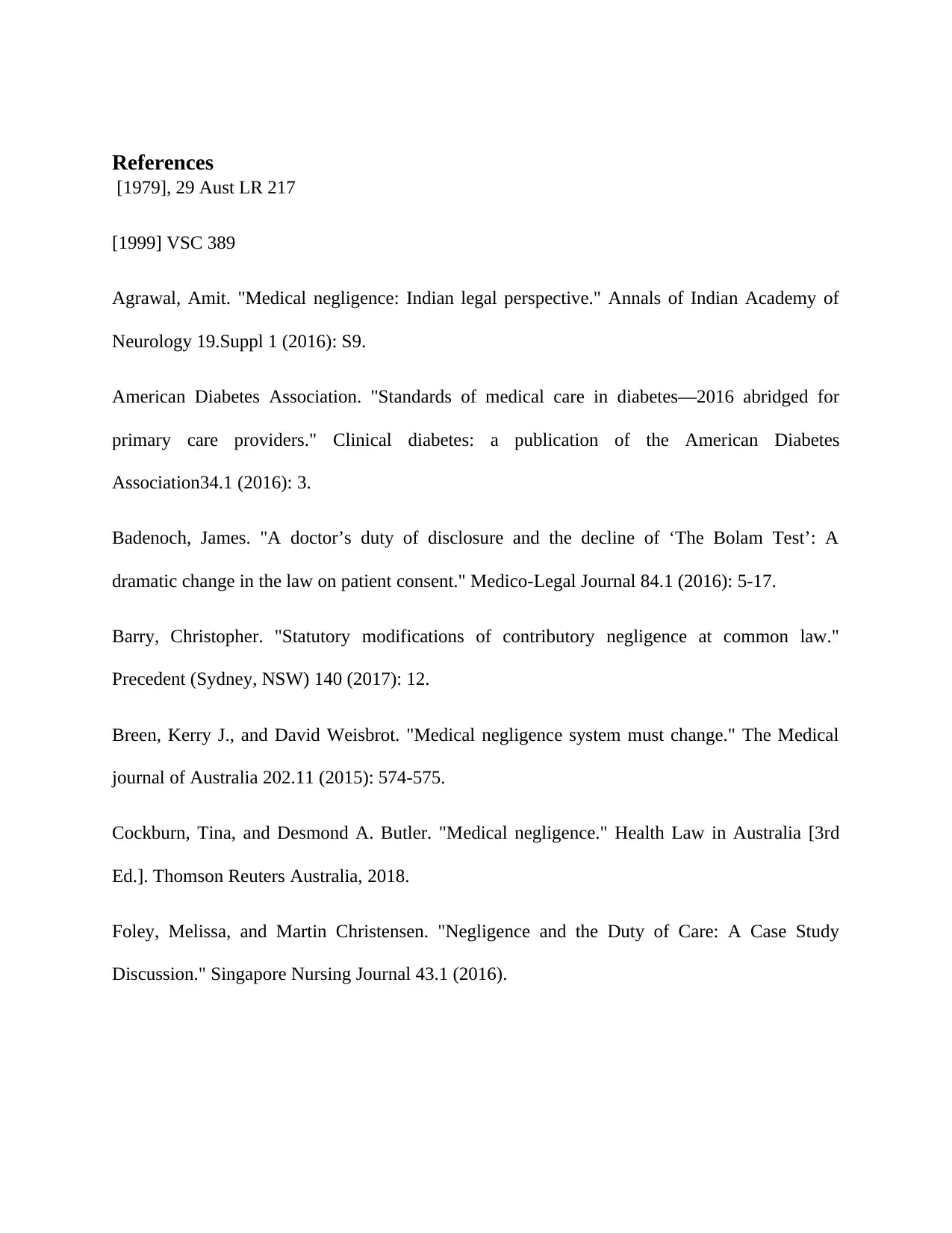
References
[1979], 29 Aust LR 217
[1999] VSC 389
Agrawal, Amit. "Medical negligence: Indian legal perspective." Annals of Indian Academy of
Neurology 19.Suppl 1 (2016): S9.
American Diabetes Association. "Standards of medical care in diabetes—2016 abridged for
primary care providers." Clinical diabetes: a publication of the American Diabetes
Association34.1 (2016): 3.
Badenoch, James. "A doctor’s duty of disclosure and the decline of ‘The Bolam Test’: A
dramatic change in the law on patient consent." Medico-Legal Journal 84.1 (2016): 5-17.
Barry, Christopher. "Statutory modifications of contributory negligence at common law."
Precedent (Sydney, NSW) 140 (2017): 12.
Breen, Kerry J., and David Weisbrot. "Medical negligence system must change." The Medical
journal of Australia 202.11 (2015): 574-575.
Cockburn, Tina, and Desmond A. Butler. "Medical negligence." Health Law in Australia [3rd
Ed.]. Thomson Reuters Australia, 2018.
Foley, Melissa, and Martin Christensen. "Negligence and the Duty of Care: A Case Study
Discussion." Singapore Nursing Journal 43.1 (2016).
[1979], 29 Aust LR 217
[1999] VSC 389
Agrawal, Amit. "Medical negligence: Indian legal perspective." Annals of Indian Academy of
Neurology 19.Suppl 1 (2016): S9.
American Diabetes Association. "Standards of medical care in diabetes—2016 abridged for
primary care providers." Clinical diabetes: a publication of the American Diabetes
Association34.1 (2016): 3.
Badenoch, James. "A doctor’s duty of disclosure and the decline of ‘The Bolam Test’: A
dramatic change in the law on patient consent." Medico-Legal Journal 84.1 (2016): 5-17.
Barry, Christopher. "Statutory modifications of contributory negligence at common law."
Precedent (Sydney, NSW) 140 (2017): 12.
Breen, Kerry J., and David Weisbrot. "Medical negligence system must change." The Medical
journal of Australia 202.11 (2015): 574-575.
Cockburn, Tina, and Desmond A. Butler. "Medical negligence." Health Law in Australia [3rd
Ed.]. Thomson Reuters Australia, 2018.
Foley, Melissa, and Martin Christensen. "Negligence and the Duty of Care: A Case Study
Discussion." Singapore Nursing Journal 43.1 (2016).
Secure Best Marks with AI Grader
Need help grading? Try our AI Grader for instant feedback on your assignments.
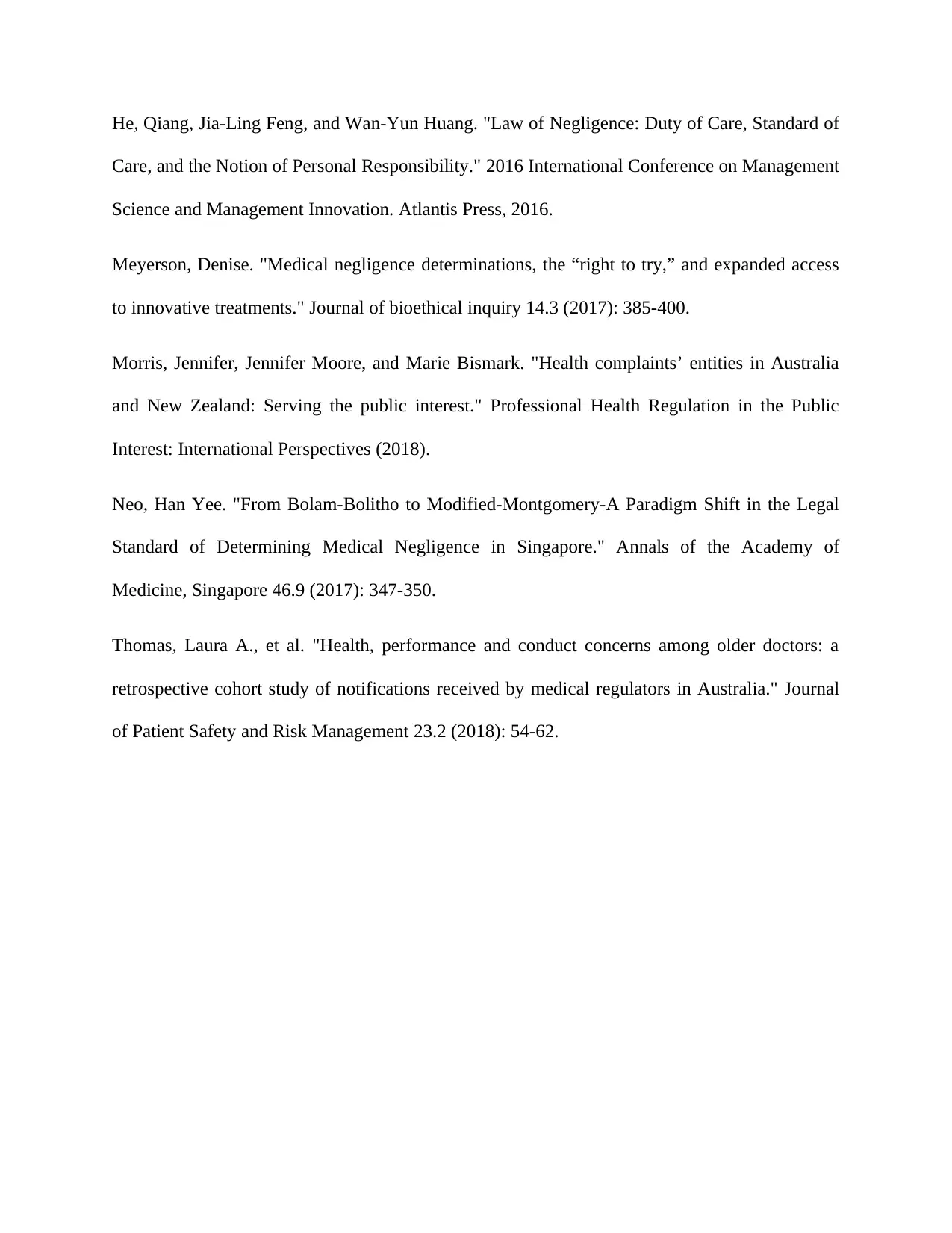
He, Qiang, Jia-Ling Feng, and Wan-Yun Huang. "Law of Negligence: Duty of Care, Standard of
Care, and the Notion of Personal Responsibility." 2016 International Conference on Management
Science and Management Innovation. Atlantis Press, 2016.
Meyerson, Denise. "Medical negligence determinations, the “right to try,” and expanded access
to innovative treatments." Journal of bioethical inquiry 14.3 (2017): 385-400.
Morris, Jennifer, Jennifer Moore, and Marie Bismark. "Health complaints’ entities in Australia
and New Zealand: Serving the public interest." Professional Health Regulation in the Public
Interest: International Perspectives (2018).
Neo, Han Yee. "From Bolam-Bolitho to Modified-Montgomery-A Paradigm Shift in the Legal
Standard of Determining Medical Negligence in Singapore." Annals of the Academy of
Medicine, Singapore 46.9 (2017): 347-350.
Thomas, Laura A., et al. "Health, performance and conduct concerns among older doctors: a
retrospective cohort study of notifications received by medical regulators in Australia." Journal
of Patient Safety and Risk Management 23.2 (2018): 54-62.
Care, and the Notion of Personal Responsibility." 2016 International Conference on Management
Science and Management Innovation. Atlantis Press, 2016.
Meyerson, Denise. "Medical negligence determinations, the “right to try,” and expanded access
to innovative treatments." Journal of bioethical inquiry 14.3 (2017): 385-400.
Morris, Jennifer, Jennifer Moore, and Marie Bismark. "Health complaints’ entities in Australia
and New Zealand: Serving the public interest." Professional Health Regulation in the Public
Interest: International Perspectives (2018).
Neo, Han Yee. "From Bolam-Bolitho to Modified-Montgomery-A Paradigm Shift in the Legal
Standard of Determining Medical Negligence in Singapore." Annals of the Academy of
Medicine, Singapore 46.9 (2017): 347-350.
Thomas, Laura A., et al. "Health, performance and conduct concerns among older doctors: a
retrospective cohort study of notifications received by medical regulators in Australia." Journal
of Patient Safety and Risk Management 23.2 (2018): 54-62.
1 out of 11
Related Documents
Your All-in-One AI-Powered Toolkit for Academic Success.
+13062052269
info@desklib.com
Available 24*7 on WhatsApp / Email
![[object Object]](/_next/static/media/star-bottom.7253800d.svg)
Unlock your academic potential
© 2024 | Zucol Services PVT LTD | All rights reserved.





